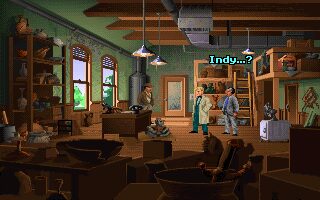Lucasfilm Games, originally known as LucasArts when it was founded in 1982, emerged as one of the most influential graphic adventure developers of the late '80s and early '90s. The company was established as the interactive entertainment division of George Lucas's film empire. The studio's breakthrough came with Maniac Mansion (1987), designed by Ron Gilbert. This bizarre horror-comedy adventure introduced the revolutionary SCUMM engine, which would become the foundation for LucasArts' legendary adventure games. Gilbert's design philosophy emphasized player-friendly mechanics, eliminating the dreaded "dead ends" and unfair deaths that plagued many Sierra adventures.
Also using the SCUMM engine, Gilbert created The Secret of Monkey Island (1990), considered one of the greatest adventure games ever made. The story of Guybrush Threepwood combined brilliant writing, memorable characters, and innovative puzzle design, in what can be considered the golden age of LucasArts adventures.
With Indiana Jones And The Last Crusade (1989) and Indiana Jones And The Fate Of Atlantis, the studio successfully translated Spielberg's film character into interactive form. Not to mention Monkey Island 2: LeChuck's Revenge, perhaps the most famous adventure in the world, or the more recent Sam & Max: Hit the Road and Full Throttle.
LucasArts also ventured into other genres with remarkable success. The studio's Star Wars flight simulators, particularly Star Wars: X-Wing (1993) and Star Wars: TIE Fighter (1994), set new standards for space simulation games, blending flight and combat dynamics with stories set in the beloved galaxy far, far away. And let's not forget the humorous shooter Zombies Ate My Neighbors that LucasArts created for home consoles.














